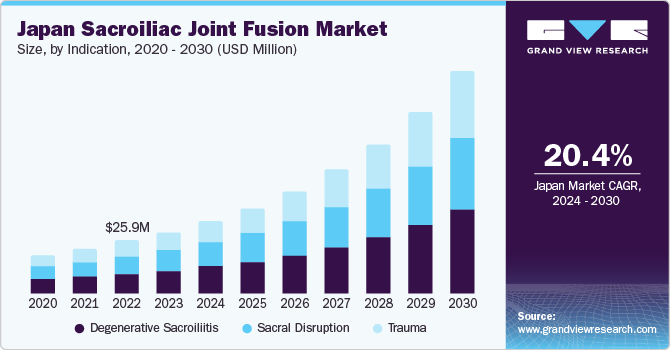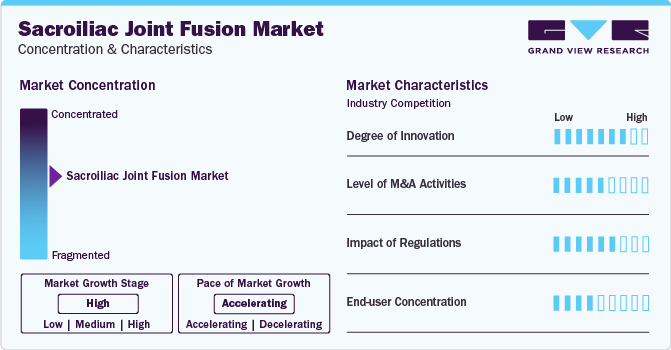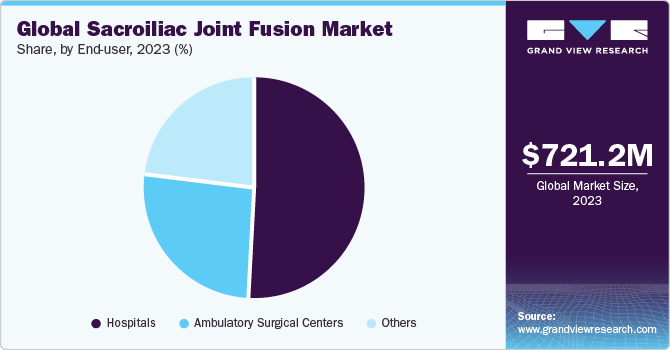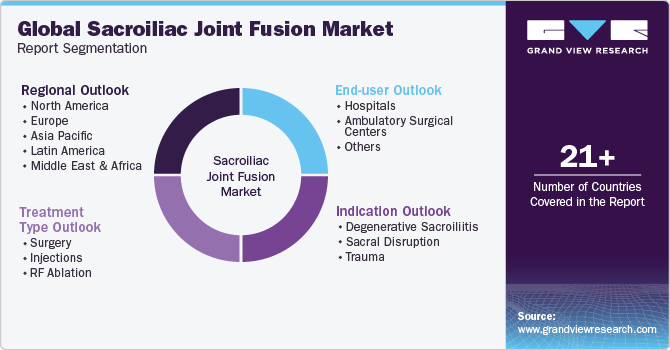- Home
- »
- Medical Devices
- »
-
Sacroiliac Joint Fusion Market Size And Share Report, 2030GVR Report cover
![Sacroiliac Joint Fusion Market Size, Share & Trends Report]()
Sacroiliac Joint Fusion Market Size, Share & Trends Analysis Report By Indication (Degenerative Sacroiliitis, Sacral Disruption), By Treatment Type (Surgery, Injections), By End-user, By Region, And Segment Forecasts, 2024 - 2030
- Report ID: GVR-4-68039-805-9
- Number of Report Pages: 162
- Format: PDF, Horizon Databook
- Historical Range: 2018 - 2022
- Forecast Period: 2024 - 2030
- Industry: Healthcare
Sacroiliac Joint Fusion Market Size & Trends
The global sacroiliac joint fusion market size was valued at USD 721.2 million in 2023 and is anticipated to grow at a compound annual growth rate (CAGR) of 19.8% from 2024 to 2030. Increasing prevalence of pain in the lower back, buttocks, groin, & lower extremities, technological advancements, and rising incidence of sacroiliitis or sacroiliac joint dysfunction are key factors fueling market growth. Furthermore, the market is driven by developments in minimally invasive surgical techniques, insurance coverage improvements, and major companies' proactive efforts. According to AmeriHealth Caritas, as of 2018, Medicaid programs in 44 U.S. states included coverage for minimally invasive sacroiliac joint fusion, and by 2019, 32 Blue Cross Blue Shield plans covered this procedure, encouraging the utilization of minimally invasive sacroiliac joint fusion procedures.

The growing adoption of new materials and technologies for creating better and safer SI joint fusion systems is anticipated to fuel the market growth over the forecast period. This includes the use of additive manufacturing and 3D-printed titanium implants. For instance, the Siros Lateral Sacroiliac Joint Fusion system by Genesys Spine comprises 3D-printed implants that offer optimal stabilization. SI-BONE’s iFuse-3D implants consist of titanium plasma spray-coated 3D implants that mimic native cancellous bone and are based on self-harvesting technology. These additively manufactured, 3D-printed implants facilitate an interconnected “bone-like” surface that may improve osteointegration.
Market Concentration & Characteristics
The global sacroiliac joint fusion market is characterized by a high degree of innovation, with new technologies and methods being developed and introduced at regular intervals. As a minimally invasive procedure that provides lower levels of pain and fatigue, it has become a popular option and as a result, market players are investing in innovative technologies and procedures to keep up with the demand.
Several market players, such as Globus Medical, Orthofix Medical, Inc., Xtant Medical, and SIGNUS Medizintechnik GmbH, are involved in merger and acquisition activities. Through M&A activity, these companies can expand their geographic reach and enter new territories. For instance, in January 2023, Orthofix Medical, Inc. and SeaSpine Holdings Corporation announced the merger of equals after receiving approval from their respective stockholders. SeaSpine's common shares attained a 99% approval rate, while Orthofix's shares achieved a 98% approval rate for the merger.

Companies invest substantial resources in R&D activities and regulatory submissions to obtain regulatory approval for pipeline products. This may result in increasing the cost of developing novel tumor ablation technologies.
The substitutes for sacroiliac joint fusion are platelet-rich plasma (PRP) injections, epidural steroid injections, and stem cell treatment. Among them, stem cells and PRP injections are a safe, effective, and natural alternative to SI joint surgery. These enable patients to avoid complications associated with surgery.
Market Dynamics
Moreover, the availability of technologically advanced devices and rapid development in healthcare infrastructure globally are anticipated to influence market growth. Growing awareness, availability, and adoption of minimally invasive surgical techniques is another factor propelling market growth. In addition, the growing participation in sports and physical activities directly impacts the growing number of sports injuries requiring medical assistance, which is expected to boost the market. For instance, according to The Johns Hopkins University, in the U.S., over 3.5 million children aged 14 and above suffer from sports injuries annually. These sports-related injuries are anticipated to drive market growth during the forecast period.
Clinical trial activities are pivotal in advancing medical treatments and technologies, particularly within the SI joint treatment market. These trials are crucial assessments of novel approaches and products, evaluating their safety and efficacy. Key aspects of these trials include investments in technological advancements, innovative product development, and the pursuit of less invasive treatment methods. Market players with robust product portfolios allocate significant resources to drive innovation, complemented by ongoing R&D efforts to enhance product offerings. Numerous clinical trial projects are underway, spanning a spectrum of investigational treatments and therapies, to improve the diagnosis & management of SI joint dysfunction.
Clinical trial activities
Sr. No.
Condition/Disease
Intervention/Treatment
Sponsor/Collaborator
Estimated Study Completion Date
Phase
1
Total Hip Arthroplasty
Manual Correction of SI Joint & Total Hip Arthroplasty
I.M. Sechenov First Moscow State Medical University
May 2022
NA
2
Lower Back Pain & SI Joint Synovitis
SI Intra-articular Injection
University of Utah & Radiological Society of North America
June 2022
NA
3
Sacroiliac Joint Pain
SInergy Cooled Radiofrequency & Medical Management
Avanos Medical
July 2022
NA
Indication Insights
Degenerative sacroiliitis segment accounted for the largest revenue share of 38.6% in 2023. The key factors contributing to this growth include growing awareness about the condition, improving diagnostic capabilities for sacroiliac joint disorders, and a high prevalence of degenerative sacroiliitis. For instance, in March 2022, according to an article by the American Academy of Family Physicians, sacroiliac joint degeneration prevalence was 25.0% in adult patients. In addition, sacroiliac joint fusion surgery may be recommended in patients with chronic pain who fail to respond to conservative care. The high prevalence of contributing conditions to degenerative sacroiliitis and the increasing diagnosis rate is expected to fuel market growth.
Trauma segment is anticipated to witness the fastest market growth over the forecast period. Trauma in the context of pelvic ring injuries is another instance of sacroiliac joint injury. These include lateral compression, anteroposterior compression, and vertical shear-type injuries. Traumatic sacroiliac joint injuries may often need prompt surgical repair. The complexity, severity, and high incidence rate are expected to contribute to segment growth over the forecast period.
Treatment Type Insights
Surgery segment accounted for the largest revenue share in 2023. The increasing preference for minimally invasive surgeries due to the associated benefits, such as smaller incisions, reduced pain & scarring, and faster recovery times, is a major factor contributing to the high share of this segment. According to the Washington State Health Care Authority’s 2021 report, minimally invasive SI joint fusion surgery was more effective than open fusion for reducing pain. It is also associated with a shorter length of stay at the hospital. This, combined with the rising number of clinical studies using the MIS approach compared to the open approach, is further anticipated to drive the segment growth.
Radiofrequency (RF) ablation segment is estimated to register the fastest CAGR over the forecast period. Radiofrequency ablation provides moderate pain relief and helps restore function for daily movements. Conventional continuous radiofrequency, pulsed, or water-cooled radiofrequency ablation may produce heat lesions to treat sacroiliac joint pain. Increasing awareness about sacroiliac joint pain & its treatment options, research initiatives, and prevalence of risk factors is expected to contribute to segment growth.
End-user Insights
Hospital segment dominated the market with a revenue share in 2023. Key factors contributing to the growth of this segment include a higher volume of surgeries performed in hospitals and a growing preference for minimally invasive surgeries. For instance, according to the American Hospital Association, there were around 6,129 hospitals in the U.S. in 2023. Furthermore, hospitals provide specialized, long-term care to patients. Moreover, treatments at these facilities are often reimbursed, driving their adoption.

Ambulatory surgical centers (ASCs) segment has been anticipated to grow at the fastest rate during the forecast period, owing to the rising number of ASCs. For instance, Centers for Medicare & Medicaid Services (CMS), in December 2022, there were around 458 Medicare-certified ASCs in Texas state, 183 in Washington, 468 in Florida, 848 in California, and 386 in Georgia. These numbers are anticipated to increase over the forecast period, supporting segment growth. In addition, these centers enable large volumes of surgeries in short periods, thus further driving the segment.
Regional Insights
North America dominated the overall sacroiliac joint fusion industry for the revenue share of 41.1% in 2023. The dominance can be attributed to advanced healthcare infrastructure, the presence of key companies, and growing reimbursement coverage. Key market players are involved in implementing strategic initiatives, such as conducting clinical tests of their products, regional expansion, patent applications, product launches, and partnerships & collaborations to increase their market share. For instance, in September 2021, PainTEQ was granted three patents for its abrading device used in the procedure, a drill-less method of stabilizing an SI joint, and an allograft implant, respectively, in the U.S. All three solutions are part of PainTEQ’s minimally invasive LinQ procedure for the sacroiliac joint.
U.S. accounted for the largest share of the sacroiliac joint fusion market in North America in 2023. Growing technological developments, initiatives by key companies, and reimbursement coverage are key factors expected to propel market growth. Growing technological developments, initiatives by key companies, and reimbursement coverage are key factors expected to propel market growth. In June 2020, Orthofix Medical, Inc., for instance, launched FIREBIRD SI Fusion System in the U.S. through a limited market release. The system comprises a 3D-printed titanium bone screw for minimally invasive implantation in treating SI joint dysfunction.

Asia Pacific region is expected to grow at the fastest rate during the forecast period. This growth can be attributed to a large patient pool, developing healthcare facilities, and investments by key regional companies. SI-BONE, Inc. reported the first iFuse procedures beyond its key markets of Europe and the U.S., in countries such as Canada, Israel, Japan, Australia, Hong Kong, New Zealand, Saudi Arabia, South Africa, and Turkey, thus expanding its regional presence. Company also reported a reimbursement advantage over its competitors, with over 35 payor exclusives and 300 million lives covered.
China held significant share in the Asia Pacific region in 2023. As China has the largest population in the world, with 1.4 billion as of June 2021, it is expected to have the highest number of people at risk of chronic lower back pain associated with sacroiliac joints. The country's availability and adoption of treatment options are estimated to increase over time. Minimally invasive SI joint surgery, for instance, is increasingly preferred over open SI joint fusion due to its complexity and prolonged recovery. It is an increasingly adopted surgical method for SI joint dysfunction.
Key Companies & Market Share Insights
The global market is highly competitive. Key companies deploy strategic initiatives, such as product development, launches, and sales & marketing strategies to increase product awareness and regional expansions and partnerships to strengthen their market share. Market players are also involved in conducting clinical testing of their products, patent applications, and increasing product penetration. For instance, in September 2021, PainTEQ was granted 3 patents in the U.S. for its drill-less method of stabilizing an SI joint, abrading device used in the procedure, and allograft implant respectively. All three offerings are used in the company’s minimally invasive LinQ procedure for SI joint dysfunction, thus solidifying PainTEQ’s position in the market.
-
Medtronic, SI-BONE, Inc., SIGNUS Medizintechnik GmbH, and Globus Medical are some of the dominant players operating in the market.
-
Medtronic has a global presence and operates from over 370 locations in approximately 160 countries.
-
SI-BONE, Inc. is a company specializing in advancing tools and solutions for individuals suffering from low back problems associated with specific sacroiliac joint disorders.
-
SIGNUS Medizintechnik GmbH provides comprehensive solutions for the surgical spine care industry.
-
Surgalign Spine Technologies, Inc., CoreLink Surgical, Xtant Medical, and Life Spine, Inc. are some of the emerging market players functioning in the market.
-
Surgalign Spine Technologies, Inc. manufactures and markets its products in more than 50 countries, including the U.S.
-
CoreLink Surgical manufactures and supplies surgical implant systems to surgeons and their teams globally.
Key Sacroiliac Joint Fusion Companies:
- SI-BONE, Inc.
- PainTEQ
- CornerLoc
- SIGNUS Medizintechnik GmbH
- Globus Medical
- Orthofix Medical, Inc.
- Life Spine, Inc.
- Camber Spine Technologies, LLC
- CoreLink Surgical
- Xtant Medical
- Surgalign Spine Technologies, Inc.
- Medtronic
Recent Developments
-
In October 2022, CornerLoc unveiled the TransLoc 3D SI Joint Fusion System, a significant advancement in sacroiliac joint fixation. This system combines modular posterior implants and lateral oblique screws, enabling the creation of a versatile 3-dimensional hybrid construct or the use of screws independently for transfixing compression.
-
SI-BONE, Inc. obtained FDA clearance for its iFuse-TORQ system for pelvic fracture fixation. This system can be used to treat many fractures, including acute, nonacute, and nontraumatic types, such as pelvic fragility & pelvic insufficiency fractures. The combined market potential for these conditions is estimated at around USD 300 million.
Sacroiliac Joint Fusion Market Report Scope
Report Attribute
Details
Market size value in 2024
USD 843.0 million
Revenue forecast in 2030
USD 2.49 billion
Growth rate
CAGR of 19.8% from 2024 to 2030
Base year for estimation
2023
Historical data
2018 - 2022
Forecast period
2024 - 2030
Report updated
November 2023
Quantitative units
Revenue in USD million/billion, and CAGR from 2024 to 2030
Report coverage
Revenue forecast, company ranking, competitive landscape, growth factors, and trends
Segments covered
Indication, treatment type, end-user, region
Regional scope
North America; Europe; Asia Pacific; Latin America; MEA
Country scope
U.S.; Canada; U.K.; Germany; France; Italy; Spain; Denmark; Sweden; Norway; Japan; China; India; Australia; Thailand; South Korea; Brazil; Mexico; Argentina; South Africa; Saudi Arabia; UAE; Kuwait.
Key companies profiled
SI-BONE, Inc.; PainTEQ; CornerLoc; SIGNUS Medizintechnik GmbH; Globus Medical; Orthofix Medical, Inc.; Life Spine, Inc.; Camber Spine Technologies, LLC; CoreLink Surgical; Xtant Medical; Surgalign Spine Technologies, Inc.; Medtronic
Customization scope
Free report customization (equivalent up to 8 analysts working days) with purchase. Addition or alteration to country, regional & segment scope.
Pricing and purchase options
Avail customized purchase options to meet your exact research needs. Explore purchase options
Global Sacroiliac Joint Fusion Market Report Segmentation
This report forecasts revenue growth at global, regional & country levels and provides an analysis of the industry trends in each of the sub-segments from 2018 to 2030. For this study, Grand View Research has segmented the global sacroiliac joint fusion market report based on indication, treatment type, end-user, and region:

-
Indication Outlook (Revenue, USD Million, 2018 - 2030)
-
Degenerative Sacroiliitis
-
Sacral Disruption
-
Trauma
-
-
Treatment Type Outlook (Revenue, USD Million, 2018 - 2030)
-
Surgery
-
By Surgery Type
-
MIS
-
MIS
-
-
By Approach
-
Dorsal
-
Anterior
-
-
By Product
-
Implants
-
Accessories
-
-
-
Injections
-
Diagnosis
-
Treatment
-
-
RF Ablation
-
-
End-user Outlook (Revenue, USD Million, 2018 - 2030)
-
Hospitals
-
Ambulatory Surgical Centers
-
Others (Specialty Centers, Research & Academic Institutes)
-
-
Regional Outlook (Revenue, USD Million, 2018 - 2030)
-
North America
-
U.S.
-
Canada
-
-
Europe
-
U.K.
-
Germany
-
France
-
Italy
-
Spain
-
Denmark
-
Sweden
-
Norway
-
-
Asia Pacific
-
China
-
Japan
-
India
-
Australia
-
Thailand
-
South Korea
-
-
Latin America
-
Brazil
-
Mexico
-
Argentina
-
-
Middle East & Africa
-
South Africa
-
Saudi Arabia
-
UAE
-
Kuwait
-
-
Frequently Asked Questions About This Report
b. The global sacroiliac joint fusion market size was estimated at USD 721.2 million in 2023 and is expected to reach USD 843.0 million in 2024.
b. The global sacroiliac joint fusion market is expected to grow at a compound annual growth rate of 19.8% from 2024 to 2030 to reach USD 2.49 billion by 2030.
b. North America dominated the sacroiliac joint fusion market with a share of 41.1% in 2023. This is attributable to the presence of key players, reimbursement coverage, and advanced healthcare infrastructure.
b. Some key players operating in the sacroiliac joint fusion market include SI-BONE, Inc., PainTEQ, CornerLoc, SIGNUS Medizintechnik GmbH, Globus Medical, Orthofix Medical Inc., Life Spine, Inc., Camber Spine Technologies, LLC, CoreLink Surgical, Xtant Medical, Surgalign Spine Technologies, Inc., and Medtronic.
b. Key factors that are driving the sacroiliac joint fusion market growth include growing reimbursement coverage, technological advancements, and an aging population in several developed countries.
Share this report with your colleague or friend.
![gvr icn]()
NEED A CUSTOM REPORT?
We can customize every report - free of charge - including purchasing stand-alone sections or country-level reports, as well as offer affordable discounts for start-ups & universities. Contact us now
![Certified Icon]()
We are GDPR and CCPA compliant! Your transaction & personal information is safe and secure. For more details, please read our privacy policy.
We are committed towards customer satisfaction, and quality service.
"The quality of research they have done for us has been excellent."





